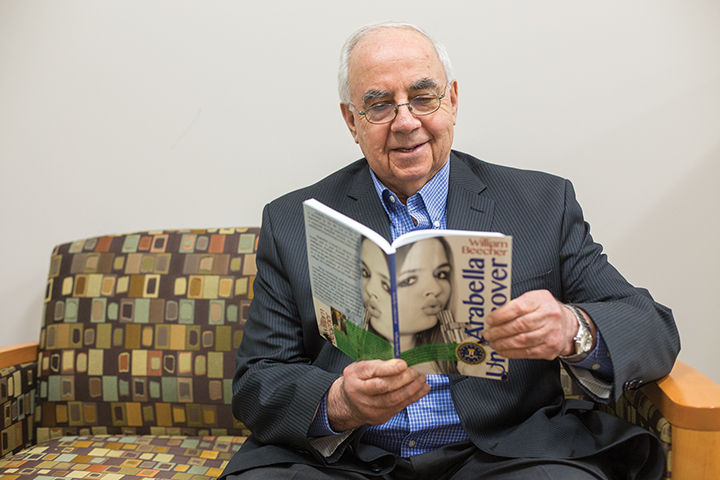This university’s faculty features countless educators with a wealth of knowledge in a variety of areas. So it’s no surprise many of them put pen to paper, publishing books that spread their wisdom to the masses.
The collective faculty might have few books on The New York Times Best Sellers list, but their individual efforts explore diverse disciplines.
Judith Hanna, William Beecher and Sunil Mithas all serve as noteworthy cases of this, having recently published books that communicate their wisdom and personal interests.

Judith Hanna
Judith Hanna
A pediatrician suggested to Hanna when she was 10 that she take up dance to strengthen her feet. Dance might not have accomplished that brief for Hanna, but, in the process, she became passionate about the art form, eventually earning a doctorate in anthropology with a focus on the relationship between dance and society.
Hanna, an anthropology professor, has applied her expertise to 11 books, including her latest, Dancing to Learn: The Brain’s Cognition, Emotion, and Movement.
“It draws on recent findings from neuroscience,” Hanna said. “And it turns out that neuroscientists are studying dancers’ brains because what’s involved in dance is a very complex phenomena that involves mind, body and emotions.”
The book contextualizes discoveries that suggest the brain choreographs the dance-maker, dancer and spectator. Hanna synthesized the research in the book with her expertise in the arts, humanities, social sciences and education.
Hanna describes writing as a way for her to share the new things she is learning.
“I’m one of these people who doesn’t like to waste anything, so if I’ve been digging and learning, I feel like I should share it,” Hanna said. “I like to advance knowledge.”
But Hanna explained that writing Dancing to Learn was no simple task. As an anthropologist, going through a large amount of neuroscience research was a departure from the physical anthropology Hanna is used to doing.
But Hanna found it important to share this information in her latest book, especially because it pertains to dance. Hanna wants her readers to understand the importance of dance and support her favorite art form.
“Dance has gotten a bad rap,” she said. “It is the Cinderella of the arts.”

William Beecher
William Beecher
William Beecher, a Pulitzer Prize-winning journalist. added a slightly surprising facet to his career and two years with the Defense Department when he decided to use his occupational experience to write a series of fictional novels.
“Some people thought I was writing fiction all those years when I was working for newspapers,” Beecher said. “But that, of course, was not the case.”
Beecher, a journalism professor, traveled often throughout his career, going abroad annually for two to three months for more than 25 years.
“In the course of that, [I] had all sorts of interesting experiences, encountered all sorts of interesting people, including people in intelligence,” Beecher said. “And various story ideas popped into my head as I was moving around.”
Beecher penned his first novel, Mayday Man, in 1990. According to Beecher, former President George H. W. Bush once cited it as one of his favorites. After Mayday Man, Beecher never thought he would write another novel, but wound up adding five more to the collection with two novels on the way.
“They’re all basically thrillers,” Beecher said. “I tend to write about spies, counterspies and loose women.”
Beecher’s pursuits as a novelist contrast his career in journalism where reporters must write the facts. While he asserts his novels are thoroughly researched, per his journalistic instincts, he is also dedicated to making his stories compelling.
“I enjoy writing fiction because, in fiction, it’s a world of your own creation,” Beecher said. “You control the situation, the problems, how you overcome the problems, the person, the personalities. You’re kind of a mini God when you’re writing fiction because it’s all under your own control.”
Beecher expects to release two more novels within the next two years, including one involving the Russian foreign intelligence recruiting at this university’s campus. He’s even heard interest about making a film out of one of his stories. But Beecher views his fiction writing as an outlet for himself, which he hopes others will appreciate.
“If you do a lot of work to write a book, you want people to enjoy it,” he said. “That’s the only point. That’s why I write, because I enjoy writing and I enjoy the fact that people like my books.”

Mithas
Sunil Mithas
Mithas spent almost a decade working at Tata Group, one of India’s largest business groups, which owns brands such as Jaguar Land Rover and Tetley. That made Mithas the right man to catalog the 147-year-old company’s recent transformation.
Tata Group’s success, which includes increasing its revenues from about $6 billion to about $103 billion in about 22 years, stems from its adoption of the Tata Business Excellence Model, derived from the Malcolm Baldrige Criteria for Performance Excellence developed by the National Institute of Standards and Technology, according to Mithas.
Mithas’ new book, Dancing Elephants and Leaping Jaguars: How to Excel, Innovate, and Transform Your Organization the Tata Way, closely examines how the group used these criteria in the last few decades across several of its top companies.
“When they started adopting this criteria, I was very closely involved in [implementing and assessing] that myself,” Mithas said. “So I have seen what it has done at the grassroots level, and I was also one of the senior examiners for Tata Business Excellence Model before I left India in 2000.”
Mithas, a professor in the business school, continued to stay in touch with the Tata Group and interviewed key executives and decision-makers. He conducted interviews with CEOs of at least six of Tata Group’s leading companies while researching for the book.
“I thought I was in a good position to reflect on my own experiences and also combine that with my research to basically think about transformation of a very large company,” Mithas said.
This idea of transformation led to the memorable title of Dancing Elephants and Leaping Jaguars, which he explained is meant to reflect the ability of the framework described in the book to apply to organization large and small.
“You can think of elephants as incumbents and large organizations, so you can transform them,” Mithas said. “At the same time, you can also transform other organizations to have the agility of a jaguar. The framework is, I think, industry-agnostic and flexible enough that it can help you to achieve outcomes, regardless of whether you are leading an elephant or a jaguar.”
Mithas hopes his book will carry the message of the applicability of the Tata Group’s model to university or other settings. Mithas said a book was an ideal medium to make this information more accessible.
“Research papers are typically shorter,” he said. “You are basically addressing a very narrow topic. The book allows you much more freedom to talk about bigger things or to connect the dots.”
On some level, Mithas said, he wants his book to reach practitioners and decision-makers, who can learn from the successful practices of the Tata Group
“There is much to learn here from a widely admired group whose practices and performance have withstood the test of time,” Mithas said.
Professor William Beecher poses for a photo in Knight Hall.






